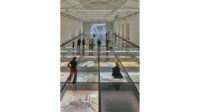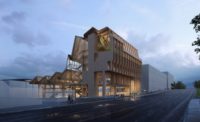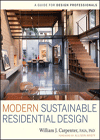When Bolle Tham and Martin Videgård opened their Stockholm office 10 years ago, the established architecture in Sweden was, according to them, boring. “We wanted to provide something different from what was out there, something more progressive and contemporary,” Tham recalls. But rather than offering a radical alternative, the twosome relied on subtle shifts in scale and unexpected material choices to create buildings whose surprising simplicity turned out to be a refreshing twist.
Like most young architecture firms just starting out, Tham & Videgård worked mainly on residential projects, developing a niche designing small summer houses in remote locations — a common building type in Sweden, as city dwellers escape to the countryside to enjoy the natural landscape following the long, cold winters. The remoteness of these settings presented both challenges for construction and opportunities for innovative design. For two houses on the outer islands of the Stockholm archipelago inaccessible to car traffic (and thus difficult to supply with building materials), Tham & Videgård built lightweight structures around compact but clever floor plans. For one, on Söderöra Island, the architects wrapped the entire house, like a mummy, in a standard bitumen roofing membrane. “We opted for a solution in which you can see detailing and craftsmanship in the facade,” says Videgård. In the other, they covered the exterior with black-stained plywood planks.
This was not the first time the architects used plywood cladding to create an expressive facade, nor would it be the last. But their decision to clad a museum in this way turned a design for a simple black box containing art into a subversive statement. “This is a ‘low’ material,” admits Tham. “It’s not like stone or glass, which you would typically associate with a public building.” Nevertheless, Tham & Videgård’s proposal for the Kalmar Museum of Art, in the Renaissance city of Kalmar, was selected out of 294 entries in an open, international competition whose theme was “Platform.” Completed in May 2008, the cast-concrete building houses a series of open platforms for art-related activities while providing expansive views of the surrounding park and the historic town’s center.
That competition win brought attention to the growing firm, and invitations to competitions soon followed. In a 2007 invited competition — among a field of architects that included the Japanese firm SANAA and influential Swedish architect Gert Wingårdh — Tham & Videgård won first prize for its design of a new School of Architecture building at Stockholm’s Royal Institute of Technology, where both partners had studied. (A new campus entrance building is also part of the commission.) While they jokingly call designing a school of architecture “architecture suicide,” the project is moving forward and is scheduled for completion in 2013. This time, the architects chose to clad the structure in weathering steel, its deep red color matching the dark brick of the surrounding campus buildings, designed in the Nordic National Romantic style of the early 20th century. The building’s rounded form is a departure from the angular geometries the architects employed in their earlier work, but is one they have used again in the design of a nursery school currently under construction in Stockholm. There, the organic layout and common interior plaza encourage movement and interaction among the children around different activities.
While it still designs private residences (including the recently completed Humlegården Apartment), the 10-person firm is presently juggling several projects, many of them public buildings. Its conversion of a former electricity plant in Malmö into a new branch of the Moderna Museet (Museum of Modern Art) is expected to open this winter. “We enjoy doing public projects because they belong to everybody,” Tham says.























Post a comment to this article
Report Abusive Comment